PRM701 Project Management: ERP Implementation Project Report for ATC
VerifiedAdded on 2022/11/25
|19
|3563
|284
Report
AI Summary
This report outlines a project for implementing an Enterprise Resource Planning (ERP) system at ATC, aiming to improve operational efficiency and information sharing. The project includes a detailed project background, defining SMART goals to increase efficiency by 50% within 3 months. It specifies project objectives, deliverables (including software, reports, and contracts), and strategic alignment with ATC's goals. A comprehensive project schedule with milestones, requirements, and a work breakdown structure is provided. The report also addresses risk management, including risk assessment, mitigation plans for potential issues like lack of funds, stakeholder support, and budget/time overruns, and a project budget is also discussed. Finally, a communication plan is included to improve the effectiveness of communication within the organization. The project aims to create a centralized data hub to streamline operations and improve decision-making within ATC.

Project Management
Paraphrase This Document
Need a fresh take? Get an instant paraphrase of this document with our AI Paraphraser

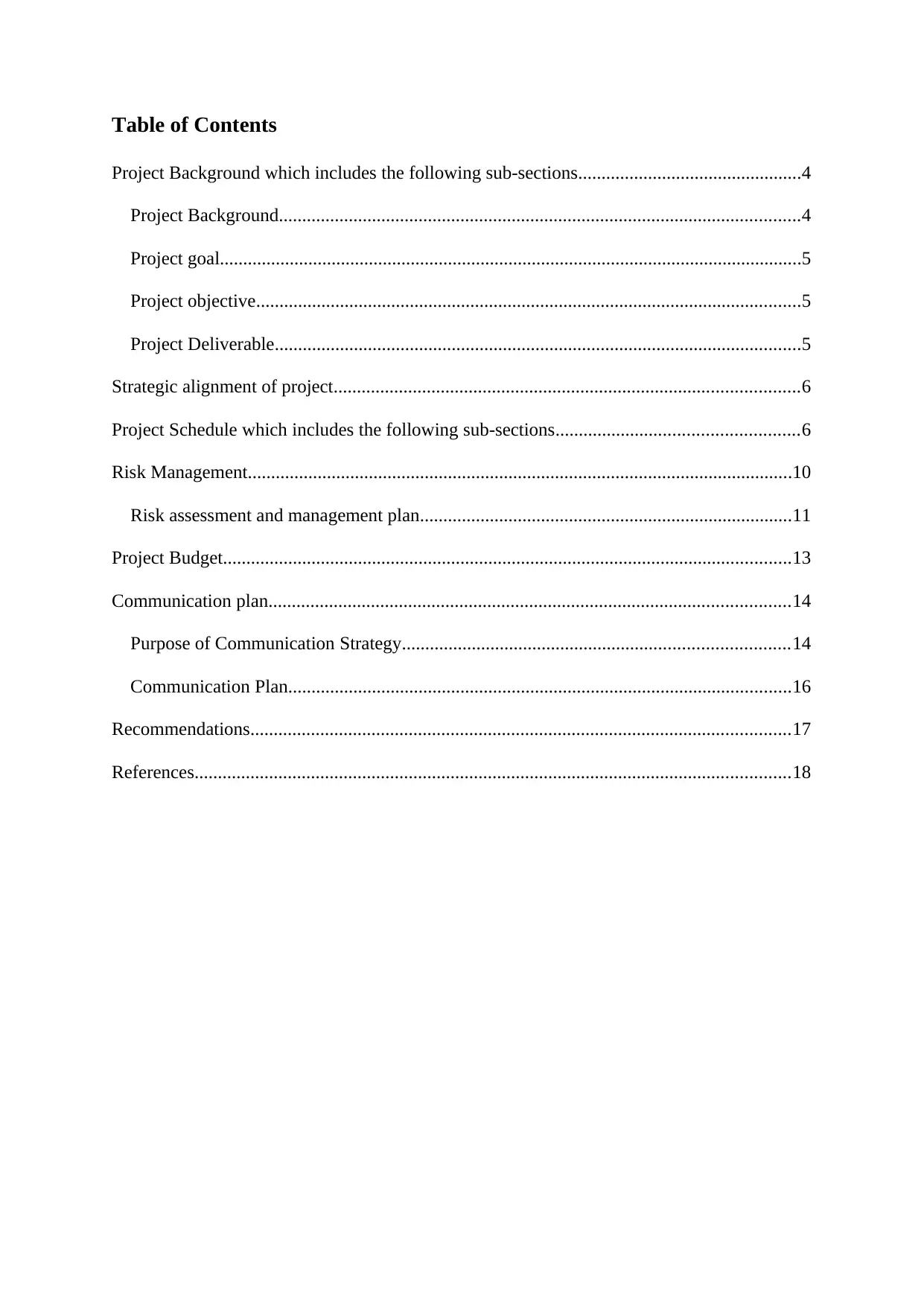
Table of Contents
Project Background which includes the following sub-sections................................................4
Project Background................................................................................................................4
Project goal.............................................................................................................................5
Project objective.....................................................................................................................5
Project Deliverable.................................................................................................................5
Strategic alignment of project....................................................................................................6
Project Schedule which includes the following sub-sections....................................................6
Risk Management.....................................................................................................................10
Risk assessment and management plan................................................................................11
Project Budget..........................................................................................................................13
Communication plan................................................................................................................14
Purpose of Communication Strategy...................................................................................14
Communication Plan............................................................................................................16
Recommendations....................................................................................................................17
References................................................................................................................................18
Project Background which includes the following sub-sections................................................4
Project Background................................................................................................................4
Project goal.............................................................................................................................5
Project objective.....................................................................................................................5
Project Deliverable.................................................................................................................5
Strategic alignment of project....................................................................................................6
Project Schedule which includes the following sub-sections....................................................6
Risk Management.....................................................................................................................10
Risk assessment and management plan................................................................................11
Project Budget..........................................................................................................................13
Communication plan................................................................................................................14
Purpose of Communication Strategy...................................................................................14
Communication Plan............................................................................................................16
Recommendations....................................................................................................................17
References................................................................................................................................18
⊘ This is a preview!⊘
Do you want full access?
Subscribe today to unlock all pages.

Trusted by 1+ million students worldwide
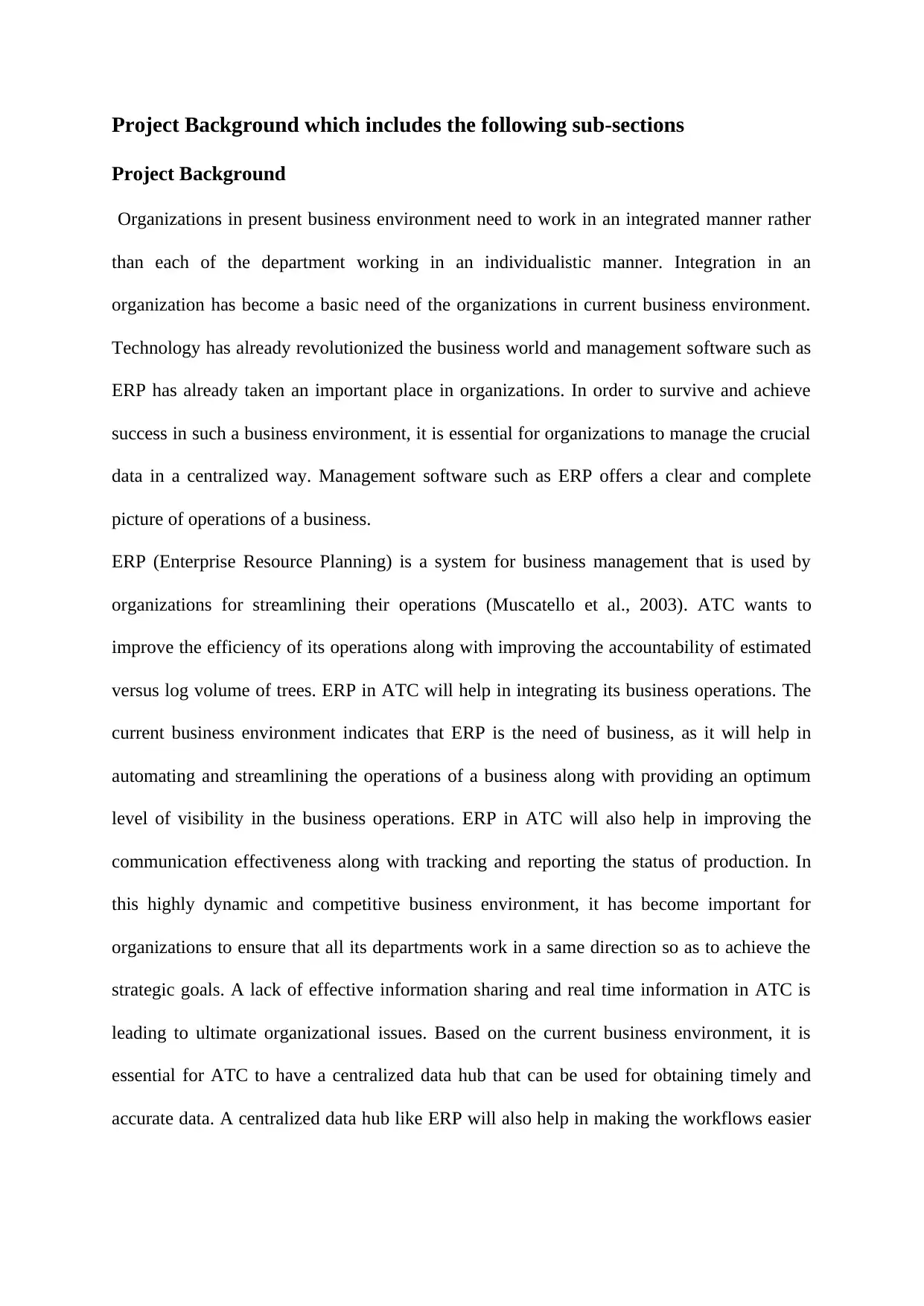
Project Background which includes the following sub-sections
Project Background
Organizations in present business environment need to work in an integrated manner rather
than each of the department working in an individualistic manner. Integration in an
organization has become a basic need of the organizations in current business environment.
Technology has already revolutionized the business world and management software such as
ERP has already taken an important place in organizations. In order to survive and achieve
success in such a business environment, it is essential for organizations to manage the crucial
data in a centralized way. Management software such as ERP offers a clear and complete
picture of operations of a business.
ERP (Enterprise Resource Planning) is a system for business management that is used by
organizations for streamlining their operations (Muscatello et al., 2003). ATC wants to
improve the efficiency of its operations along with improving the accountability of estimated
versus log volume of trees. ERP in ATC will help in integrating its business operations. The
current business environment indicates that ERP is the need of business, as it will help in
automating and streamlining the operations of a business along with providing an optimum
level of visibility in the business operations. ERP in ATC will also help in improving the
communication effectiveness along with tracking and reporting the status of production. In
this highly dynamic and competitive business environment, it has become important for
organizations to ensure that all its departments work in a same direction so as to achieve the
strategic goals. A lack of effective information sharing and real time information in ATC is
leading to ultimate organizational issues. Based on the current business environment, it is
essential for ATC to have a centralized data hub that can be used for obtaining timely and
accurate data. A centralized data hub like ERP will also help in making the workflows easier
Project Background
Organizations in present business environment need to work in an integrated manner rather
than each of the department working in an individualistic manner. Integration in an
organization has become a basic need of the organizations in current business environment.
Technology has already revolutionized the business world and management software such as
ERP has already taken an important place in organizations. In order to survive and achieve
success in such a business environment, it is essential for organizations to manage the crucial
data in a centralized way. Management software such as ERP offers a clear and complete
picture of operations of a business.
ERP (Enterprise Resource Planning) is a system for business management that is used by
organizations for streamlining their operations (Muscatello et al., 2003). ATC wants to
improve the efficiency of its operations along with improving the accountability of estimated
versus log volume of trees. ERP in ATC will help in integrating its business operations. The
current business environment indicates that ERP is the need of business, as it will help in
automating and streamlining the operations of a business along with providing an optimum
level of visibility in the business operations. ERP in ATC will also help in improving the
communication effectiveness along with tracking and reporting the status of production. In
this highly dynamic and competitive business environment, it has become important for
organizations to ensure that all its departments work in a same direction so as to achieve the
strategic goals. A lack of effective information sharing and real time information in ATC is
leading to ultimate organizational issues. Based on the current business environment, it is
essential for ATC to have a centralized data hub that can be used for obtaining timely and
accurate data. A centralized data hub like ERP will also help in making the workflows easier
Paraphrase This Document
Need a fresh take? Get an instant paraphrase of this document with our AI Paraphraser
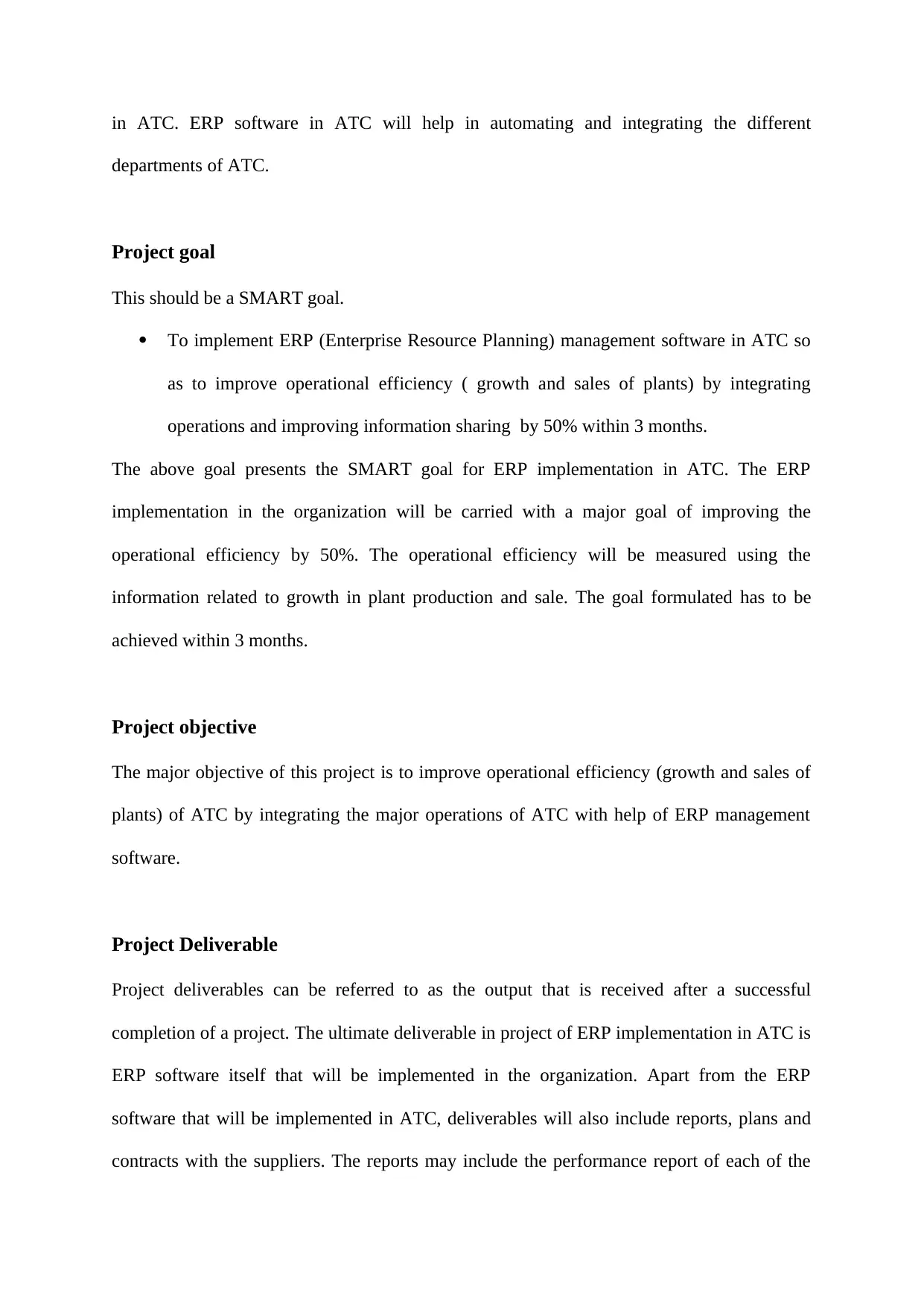
in ATC. ERP software in ATC will help in automating and integrating the different
departments of ATC.
Project goal
This should be a SMART goal.
To implement ERP (Enterprise Resource Planning) management software in ATC so
as to improve operational efficiency ( growth and sales of plants) by integrating
operations and improving information sharing by 50% within 3 months.
The above goal presents the SMART goal for ERP implementation in ATC. The ERP
implementation in the organization will be carried with a major goal of improving the
operational efficiency by 50%. The operational efficiency will be measured using the
information related to growth in plant production and sale. The goal formulated has to be
achieved within 3 months.
Project objective
The major objective of this project is to improve operational efficiency (growth and sales of
plants) of ATC by integrating the major operations of ATC with help of ERP management
software.
Project Deliverable
Project deliverables can be referred to as the output that is received after a successful
completion of a project. The ultimate deliverable in project of ERP implementation in ATC is
ERP software itself that will be implemented in the organization. Apart from the ERP
software that will be implemented in ATC, deliverables will also include reports, plans and
contracts with the suppliers. The reports may include the performance report of each of the
departments of ATC.
Project goal
This should be a SMART goal.
To implement ERP (Enterprise Resource Planning) management software in ATC so
as to improve operational efficiency ( growth and sales of plants) by integrating
operations and improving information sharing by 50% within 3 months.
The above goal presents the SMART goal for ERP implementation in ATC. The ERP
implementation in the organization will be carried with a major goal of improving the
operational efficiency by 50%. The operational efficiency will be measured using the
information related to growth in plant production and sale. The goal formulated has to be
achieved within 3 months.
Project objective
The major objective of this project is to improve operational efficiency (growth and sales of
plants) of ATC by integrating the major operations of ATC with help of ERP management
software.
Project Deliverable
Project deliverables can be referred to as the output that is received after a successful
completion of a project. The ultimate deliverable in project of ERP implementation in ATC is
ERP software itself that will be implemented in the organization. Apart from the ERP
software that will be implemented in ATC, deliverables will also include reports, plans and
contracts with the suppliers. The reports may include the performance report of each of the
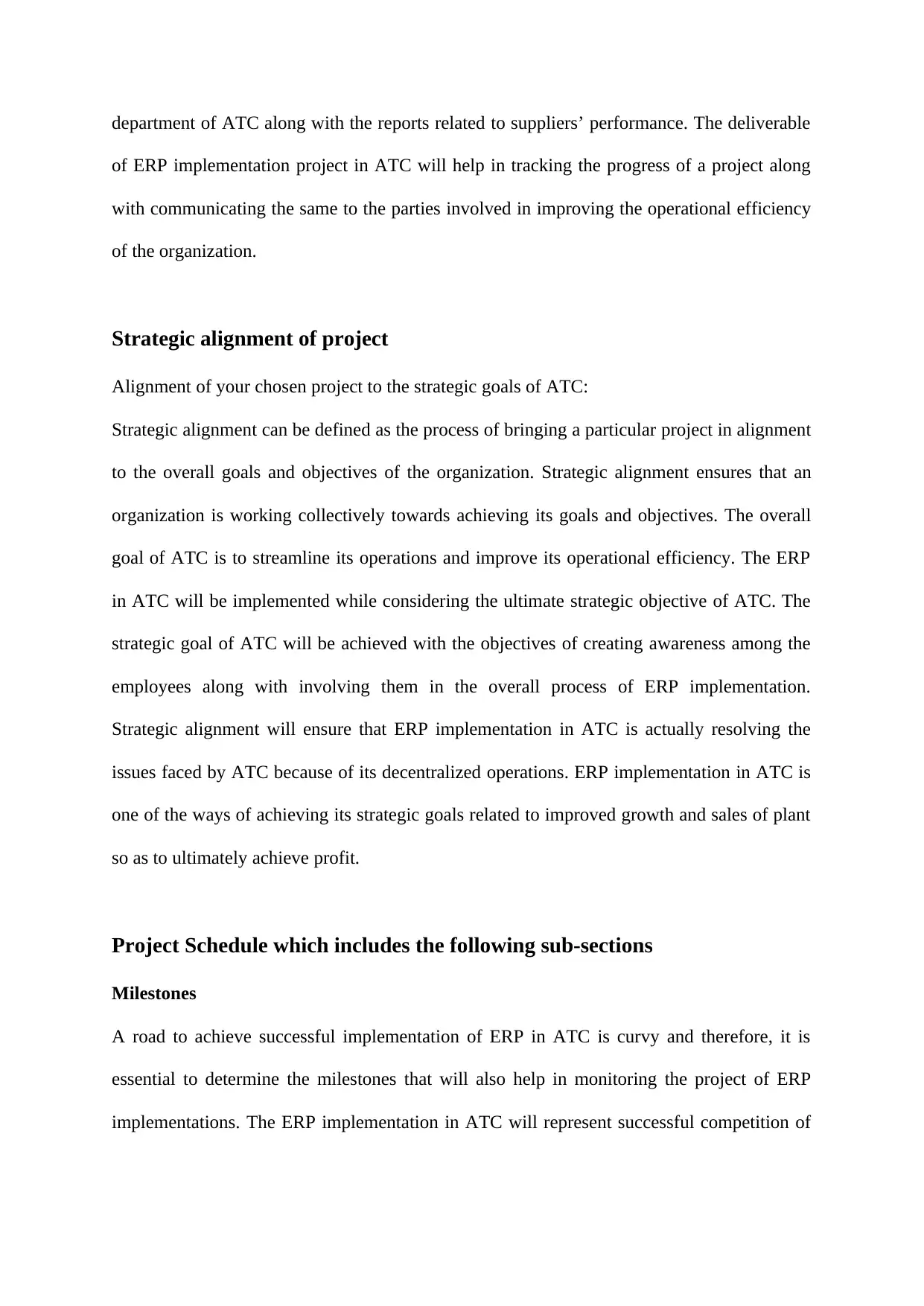
department of ATC along with the reports related to suppliers’ performance. The deliverable
of ERP implementation project in ATC will help in tracking the progress of a project along
with communicating the same to the parties involved in improving the operational efficiency
of the organization.
Strategic alignment of project
Alignment of your chosen project to the strategic goals of ATC:
Strategic alignment can be defined as the process of bringing a particular project in alignment
to the overall goals and objectives of the organization. Strategic alignment ensures that an
organization is working collectively towards achieving its goals and objectives. The overall
goal of ATC is to streamline its operations and improve its operational efficiency. The ERP
in ATC will be implemented while considering the ultimate strategic objective of ATC. The
strategic goal of ATC will be achieved with the objectives of creating awareness among the
employees along with involving them in the overall process of ERP implementation.
Strategic alignment will ensure that ERP implementation in ATC is actually resolving the
issues faced by ATC because of its decentralized operations. ERP implementation in ATC is
one of the ways of achieving its strategic goals related to improved growth and sales of plant
so as to ultimately achieve profit.
Project Schedule which includes the following sub-sections
Milestones
A road to achieve successful implementation of ERP in ATC is curvy and therefore, it is
essential to determine the milestones that will also help in monitoring the project of ERP
implementations. The ERP implementation in ATC will represent successful competition of
of ERP implementation project in ATC will help in tracking the progress of a project along
with communicating the same to the parties involved in improving the operational efficiency
of the organization.
Strategic alignment of project
Alignment of your chosen project to the strategic goals of ATC:
Strategic alignment can be defined as the process of bringing a particular project in alignment
to the overall goals and objectives of the organization. Strategic alignment ensures that an
organization is working collectively towards achieving its goals and objectives. The overall
goal of ATC is to streamline its operations and improve its operational efficiency. The ERP
in ATC will be implemented while considering the ultimate strategic objective of ATC. The
strategic goal of ATC will be achieved with the objectives of creating awareness among the
employees along with involving them in the overall process of ERP implementation.
Strategic alignment will ensure that ERP implementation in ATC is actually resolving the
issues faced by ATC because of its decentralized operations. ERP implementation in ATC is
one of the ways of achieving its strategic goals related to improved growth and sales of plant
so as to ultimately achieve profit.
Project Schedule which includes the following sub-sections
Milestones
A road to achieve successful implementation of ERP in ATC is curvy and therefore, it is
essential to determine the milestones that will also help in monitoring the project of ERP
implementations. The ERP implementation in ATC will represent successful competition of
⊘ This is a preview!⊘
Do you want full access?
Subscribe today to unlock all pages.

Trusted by 1+ million students worldwide
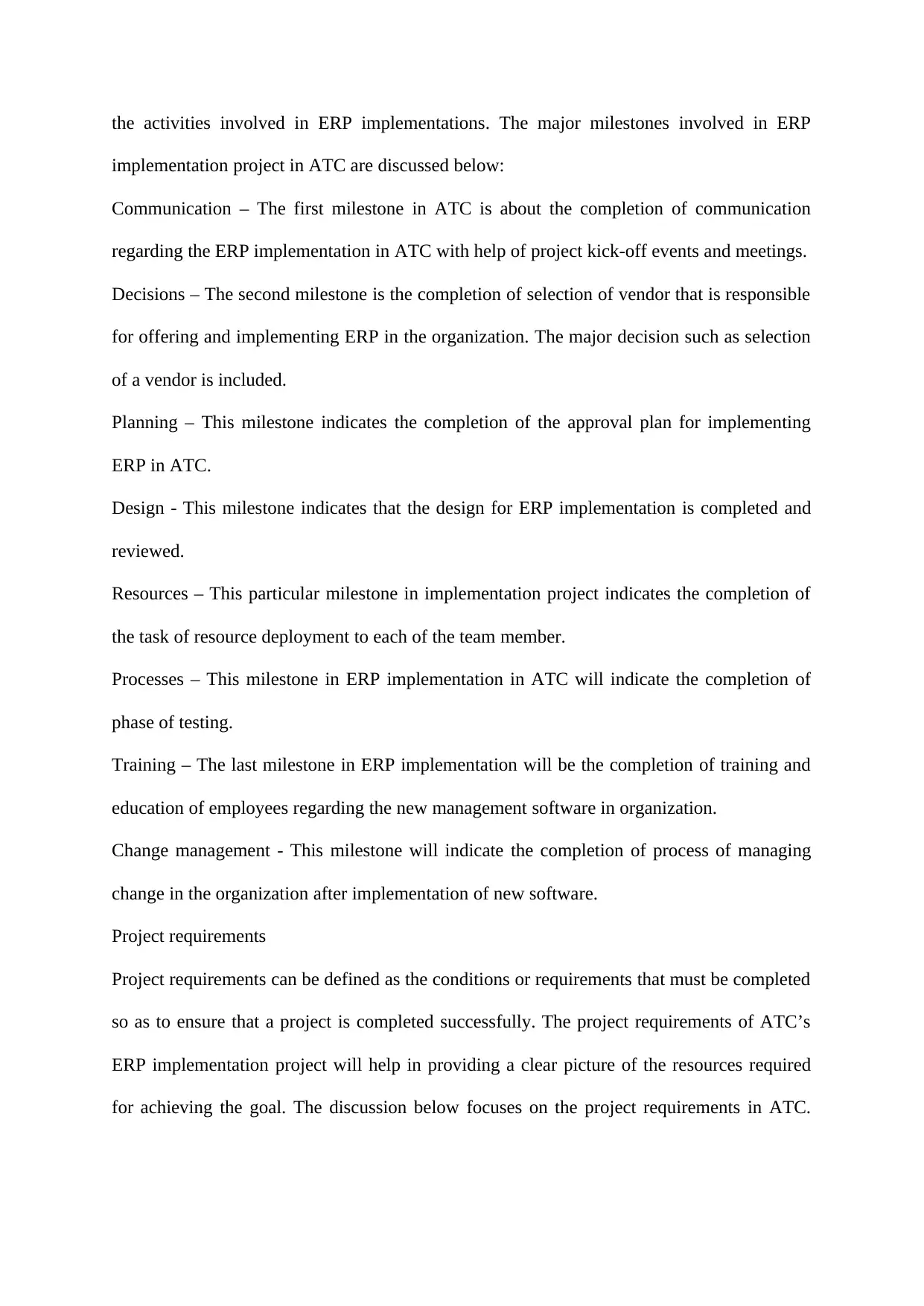
the activities involved in ERP implementations. The major milestones involved in ERP
implementation project in ATC are discussed below:
Communication – The first milestone in ATC is about the completion of communication
regarding the ERP implementation in ATC with help of project kick-off events and meetings.
Decisions – The second milestone is the completion of selection of vendor that is responsible
for offering and implementing ERP in the organization. The major decision such as selection
of a vendor is included.
Planning – This milestone indicates the completion of the approval plan for implementing
ERP in ATC.
Design - This milestone indicates that the design for ERP implementation is completed and
reviewed.
Resources – This particular milestone in implementation project indicates the completion of
the task of resource deployment to each of the team member.
Processes – This milestone in ERP implementation in ATC will indicate the completion of
phase of testing.
Training – The last milestone in ERP implementation will be the completion of training and
education of employees regarding the new management software in organization.
Change management - This milestone will indicate the completion of process of managing
change in the organization after implementation of new software.
Project requirements
Project requirements can be defined as the conditions or requirements that must be completed
so as to ensure that a project is completed successfully. The project requirements of ATC’s
ERP implementation project will help in providing a clear picture of the resources required
for achieving the goal. The discussion below focuses on the project requirements in ATC.
implementation project in ATC are discussed below:
Communication – The first milestone in ATC is about the completion of communication
regarding the ERP implementation in ATC with help of project kick-off events and meetings.
Decisions – The second milestone is the completion of selection of vendor that is responsible
for offering and implementing ERP in the organization. The major decision such as selection
of a vendor is included.
Planning – This milestone indicates the completion of the approval plan for implementing
ERP in ATC.
Design - This milestone indicates that the design for ERP implementation is completed and
reviewed.
Resources – This particular milestone in implementation project indicates the completion of
the task of resource deployment to each of the team member.
Processes – This milestone in ERP implementation in ATC will indicate the completion of
phase of testing.
Training – The last milestone in ERP implementation will be the completion of training and
education of employees regarding the new management software in organization.
Change management - This milestone will indicate the completion of process of managing
change in the organization after implementation of new software.
Project requirements
Project requirements can be defined as the conditions or requirements that must be completed
so as to ensure that a project is completed successfully. The project requirements of ATC’s
ERP implementation project will help in providing a clear picture of the resources required
for achieving the goal. The discussion below focuses on the project requirements in ATC.
Paraphrase This Document
Need a fresh take? Get an instant paraphrase of this document with our AI Paraphraser
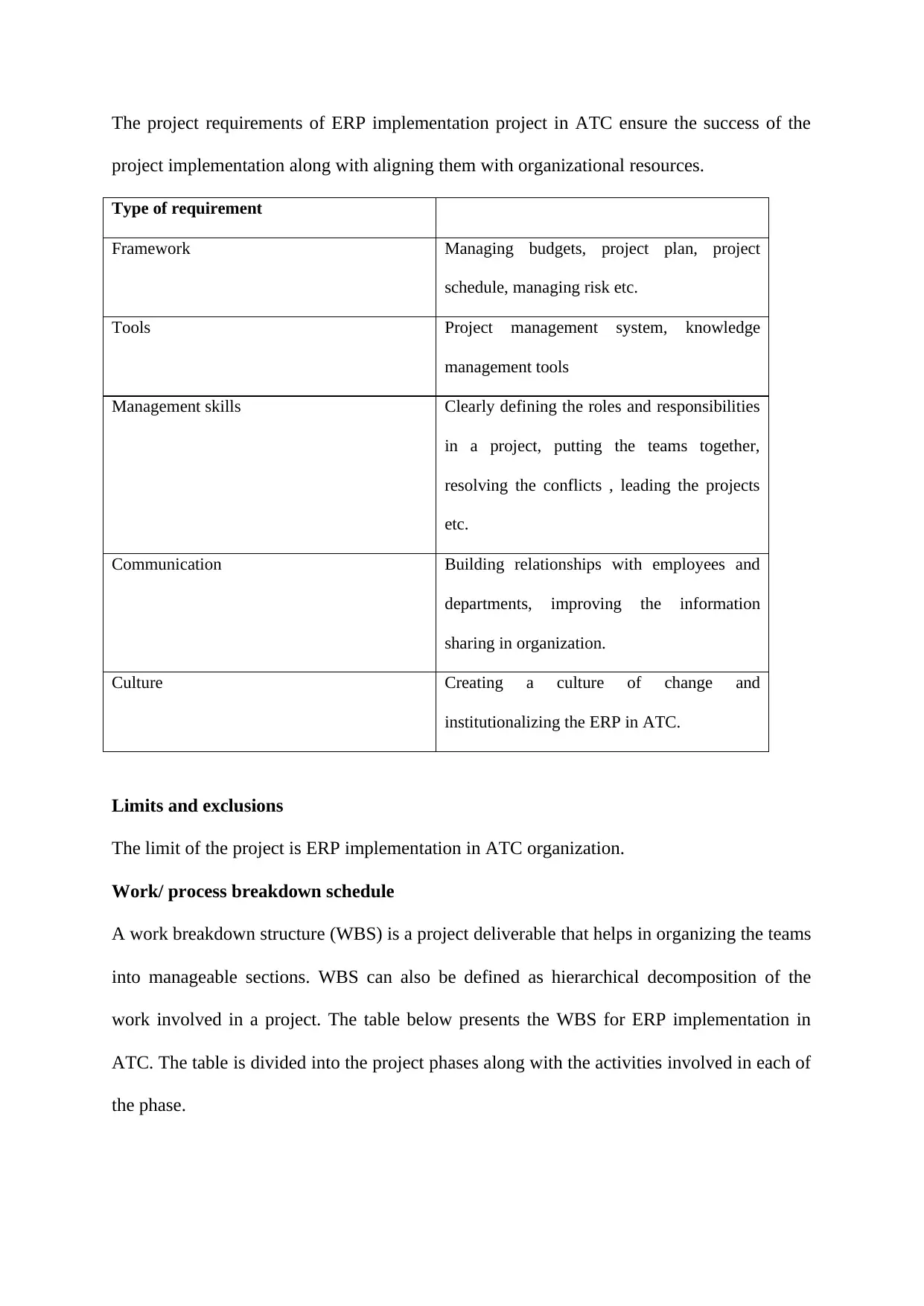
The project requirements of ERP implementation project in ATC ensure the success of the
project implementation along with aligning them with organizational resources.
Type of requirement
Framework Managing budgets, project plan, project
schedule, managing risk etc.
Tools Project management system, knowledge
management tools
Management skills Clearly defining the roles and responsibilities
in a project, putting the teams together,
resolving the conflicts , leading the projects
etc.
Communication Building relationships with employees and
departments, improving the information
sharing in organization.
Culture Creating a culture of change and
institutionalizing the ERP in ATC.
Limits and exclusions
The limit of the project is ERP implementation in ATC organization.
Work/ process breakdown schedule
A work breakdown structure (WBS) is a project deliverable that helps in organizing the teams
into manageable sections. WBS can also be defined as hierarchical decomposition of the
work involved in a project. The table below presents the WBS for ERP implementation in
ATC. The table is divided into the project phases along with the activities involved in each of
the phase.
project implementation along with aligning them with organizational resources.
Type of requirement
Framework Managing budgets, project plan, project
schedule, managing risk etc.
Tools Project management system, knowledge
management tools
Management skills Clearly defining the roles and responsibilities
in a project, putting the teams together,
resolving the conflicts , leading the projects
etc.
Communication Building relationships with employees and
departments, improving the information
sharing in organization.
Culture Creating a culture of change and
institutionalizing the ERP in ATC.
Limits and exclusions
The limit of the project is ERP implementation in ATC organization.
Work/ process breakdown schedule
A work breakdown structure (WBS) is a project deliverable that helps in organizing the teams
into manageable sections. WBS can also be defined as hierarchical decomposition of the
work involved in a project. The table below presents the WBS for ERP implementation in
ATC. The table is divided into the project phases along with the activities involved in each of
the phase.
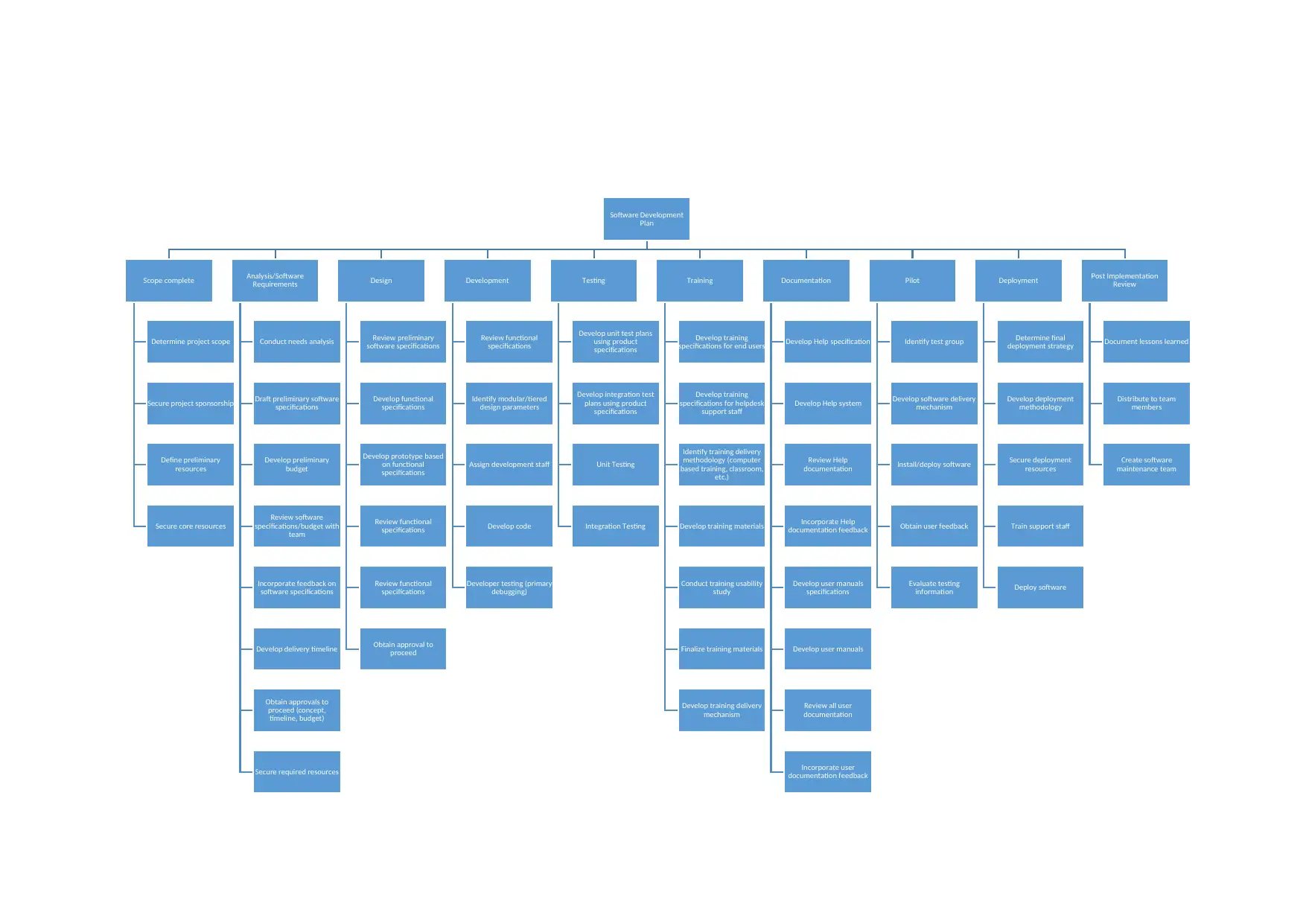
Software Development
Plan
Scope complete
Determine project scope
Secure project sponsorship
Define preliminary
resources
Secure core resources
Analysis/Software
Requirements
Conduct needs analysis
Draft preliminary software
specifications
Develop preliminary
budget
Review software
specifications/budget with
team
Incorporate feedback on
software specifications
Develop delivery timeline
Obtain approvals to
proceed (concept,
timeline, budget)
Secure required resources
Design
Review preliminary
software specifications
Develop functional
specifications
Develop prototype based
on functional
specifications
Review functional
specifications
Review functional
specifications
Obtain approval to
proceed
Development
Review functional
specifications
Identify modular/tiered
design parameters
Assign development staff
Develop code
Developer testing (primary
debugging)
Testing
Develop unit test plans
using product
specifications
Develop integration test
plans using product
specifications
Unit Testing
Integration Testing
Training
Develop training
specifications for end users
Develop training
specifications for helpdesk
support staff
Identify training delivery
methodology (computer
based training, classroom,
etc.)
Develop training materials
Conduct training usability
study
Finalize training materials
Develop training delivery
mechanism
Documentation
Develop Help specification
Develop Help system
Review Help
documentation
Incorporate Help
documentation feedback
Develop user manuals
specifications
Develop user manuals
Review all user
documentation
Incorporate user
documentation feedback
Pilot
Identify test group
Develop software delivery
mechanism
Install/deploy software
Obtain user feedback
Evaluate testing
information
Deployment
Determine final
deployment strategy
Develop deployment
methodology
Secure deployment
resources
Train support staff
Deploy software
Post Implementation
Review
Document lessons learned
Distribute to team
members
Create software
maintenance team
Plan
Scope complete
Determine project scope
Secure project sponsorship
Define preliminary
resources
Secure core resources
Analysis/Software
Requirements
Conduct needs analysis
Draft preliminary software
specifications
Develop preliminary
budget
Review software
specifications/budget with
team
Incorporate feedback on
software specifications
Develop delivery timeline
Obtain approvals to
proceed (concept,
timeline, budget)
Secure required resources
Design
Review preliminary
software specifications
Develop functional
specifications
Develop prototype based
on functional
specifications
Review functional
specifications
Review functional
specifications
Obtain approval to
proceed
Development
Review functional
specifications
Identify modular/tiered
design parameters
Assign development staff
Develop code
Developer testing (primary
debugging)
Testing
Develop unit test plans
using product
specifications
Develop integration test
plans using product
specifications
Unit Testing
Integration Testing
Training
Develop training
specifications for end users
Develop training
specifications for helpdesk
support staff
Identify training delivery
methodology (computer
based training, classroom,
etc.)
Develop training materials
Conduct training usability
study
Finalize training materials
Develop training delivery
mechanism
Documentation
Develop Help specification
Develop Help system
Review Help
documentation
Incorporate Help
documentation feedback
Develop user manuals
specifications
Develop user manuals
Review all user
documentation
Incorporate user
documentation feedback
Pilot
Identify test group
Develop software delivery
mechanism
Install/deploy software
Obtain user feedback
Evaluate testing
information
Deployment
Determine final
deployment strategy
Develop deployment
methodology
Secure deployment
resources
Train support staff
Deploy software
Post Implementation
Review
Document lessons learned
Distribute to team
members
Create software
maintenance team
⊘ This is a preview!⊘
Do you want full access?
Subscribe today to unlock all pages.

Trusted by 1+ million students worldwide
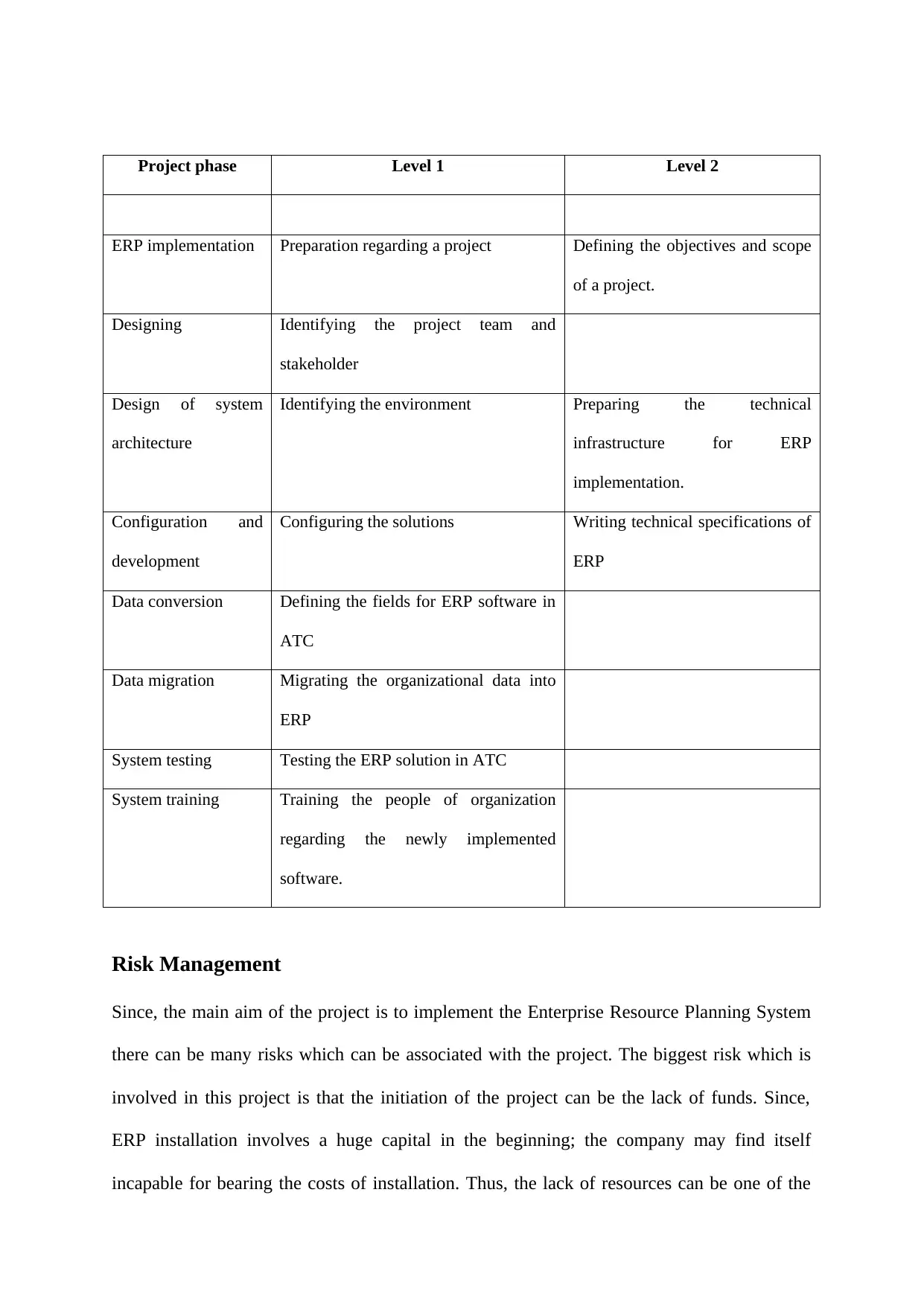
Project phase Level 1 Level 2
ERP implementation Preparation regarding a project Defining the objectives and scope
of a project.
Designing Identifying the project team and
stakeholder
Design of system
architecture
Identifying the environment Preparing the technical
infrastructure for ERP
implementation.
Configuration and
development
Configuring the solutions Writing technical specifications of
ERP
Data conversion Defining the fields for ERP software in
ATC
Data migration Migrating the organizational data into
ERP
System testing Testing the ERP solution in ATC
System training Training the people of organization
regarding the newly implemented
software.
Risk Management
Since, the main aim of the project is to implement the Enterprise Resource Planning System
there can be many risks which can be associated with the project. The biggest risk which is
involved in this project is that the initiation of the project can be the lack of funds. Since,
ERP installation involves a huge capital in the beginning; the company may find itself
incapable for bearing the costs of installation. Thus, the lack of resources can be one of the
ERP implementation Preparation regarding a project Defining the objectives and scope
of a project.
Designing Identifying the project team and
stakeholder
Design of system
architecture
Identifying the environment Preparing the technical
infrastructure for ERP
implementation.
Configuration and
development
Configuring the solutions Writing technical specifications of
ERP
Data conversion Defining the fields for ERP software in
ATC
Data migration Migrating the organizational data into
ERP
System testing Testing the ERP solution in ATC
System training Training the people of organization
regarding the newly implemented
software.
Risk Management
Since, the main aim of the project is to implement the Enterprise Resource Planning System
there can be many risks which can be associated with the project. The biggest risk which is
involved in this project is that the initiation of the project can be the lack of funds. Since,
ERP installation involves a huge capital in the beginning; the company may find itself
incapable for bearing the costs of installation. Thus, the lack of resources can be one of the
Paraphrase This Document
Need a fresh take? Get an instant paraphrase of this document with our AI Paraphraser
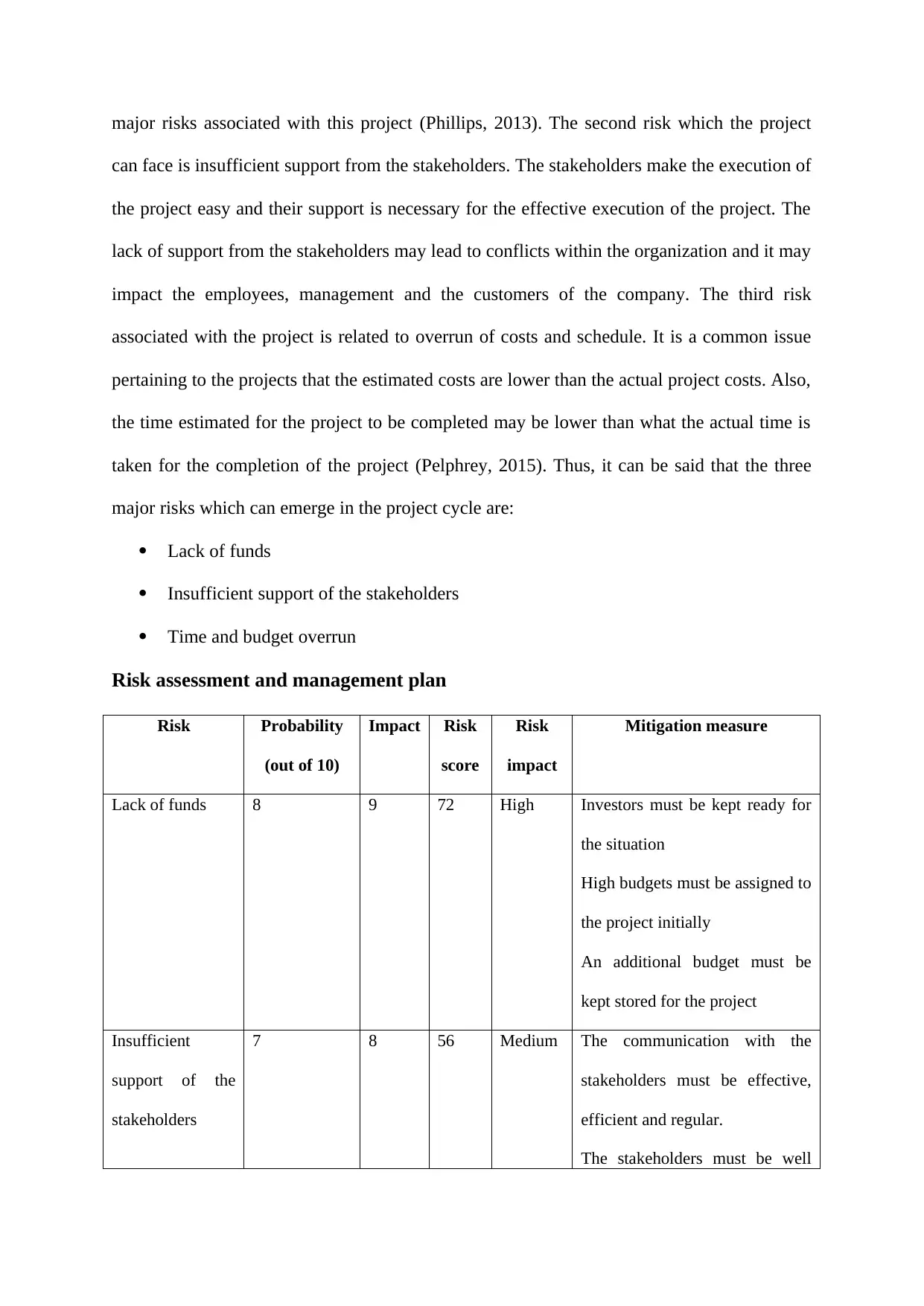
major risks associated with this project (Phillips, 2013). The second risk which the project
can face is insufficient support from the stakeholders. The stakeholders make the execution of
the project easy and their support is necessary for the effective execution of the project. The
lack of support from the stakeholders may lead to conflicts within the organization and it may
impact the employees, management and the customers of the company. The third risk
associated with the project is related to overrun of costs and schedule. It is a common issue
pertaining to the projects that the estimated costs are lower than the actual project costs. Also,
the time estimated for the project to be completed may be lower than what the actual time is
taken for the completion of the project (Pelphrey, 2015). Thus, it can be said that the three
major risks which can emerge in the project cycle are:
Lack of funds
Insufficient support of the stakeholders
Time and budget overrun
Risk assessment and management plan
Risk Probability
(out of 10)
Impact Risk
score
Risk
impact
Mitigation measure
Lack of funds 8 9 72 High Investors must be kept ready for
the situation
High budgets must be assigned to
the project initially
An additional budget must be
kept stored for the project
Insufficient
support of the
stakeholders
7 8 56 Medium The communication with the
stakeholders must be effective,
efficient and regular.
The stakeholders must be well
can face is insufficient support from the stakeholders. The stakeholders make the execution of
the project easy and their support is necessary for the effective execution of the project. The
lack of support from the stakeholders may lead to conflicts within the organization and it may
impact the employees, management and the customers of the company. The third risk
associated with the project is related to overrun of costs and schedule. It is a common issue
pertaining to the projects that the estimated costs are lower than the actual project costs. Also,
the time estimated for the project to be completed may be lower than what the actual time is
taken for the completion of the project (Pelphrey, 2015). Thus, it can be said that the three
major risks which can emerge in the project cycle are:
Lack of funds
Insufficient support of the stakeholders
Time and budget overrun
Risk assessment and management plan
Risk Probability
(out of 10)
Impact Risk
score
Risk
impact
Mitigation measure
Lack of funds 8 9 72 High Investors must be kept ready for
the situation
High budgets must be assigned to
the project initially
An additional budget must be
kept stored for the project
Insufficient
support of the
stakeholders
7 8 56 Medium The communication with the
stakeholders must be effective,
efficient and regular.
The stakeholders must be well
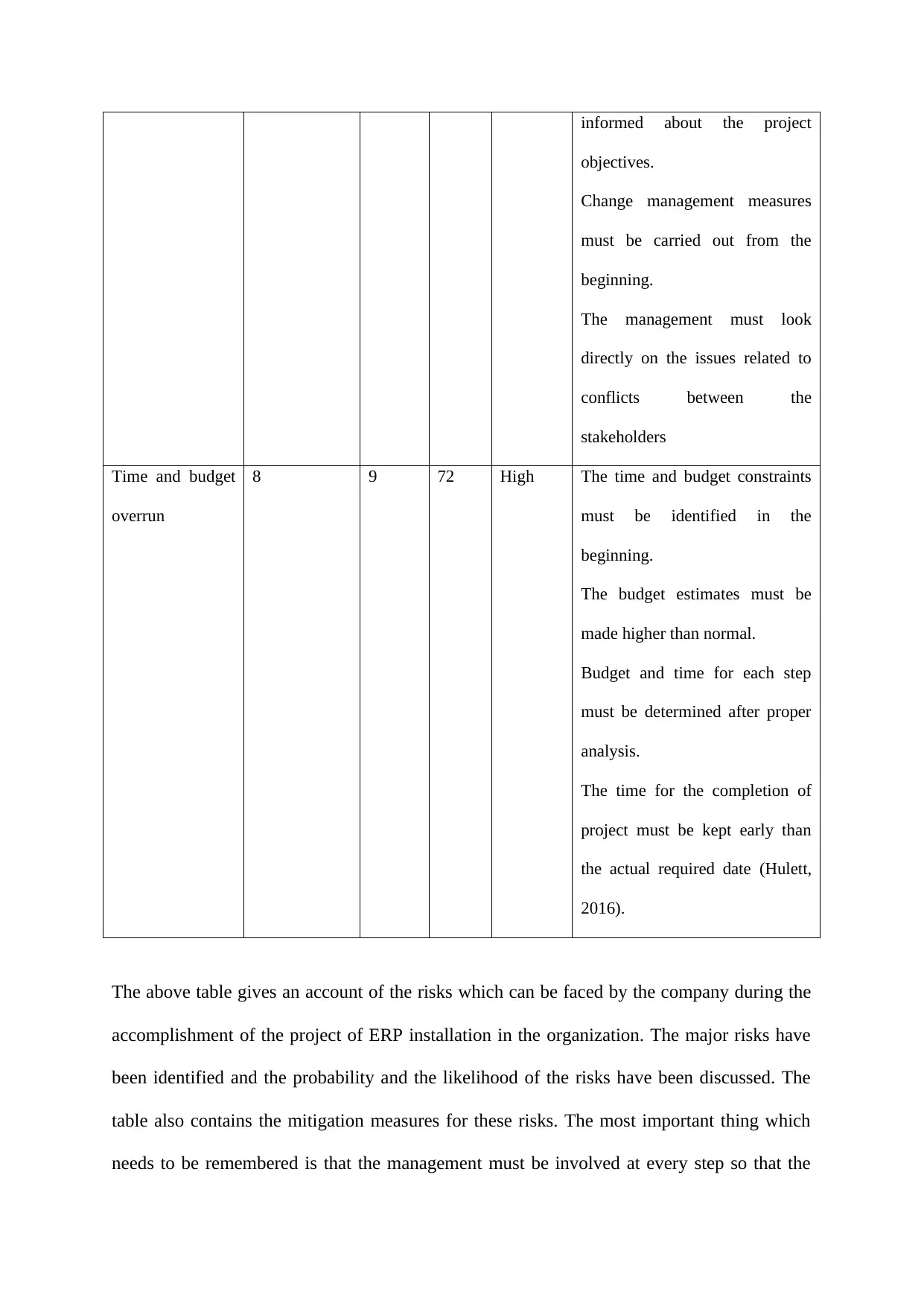
informed about the project
objectives.
Change management measures
must be carried out from the
beginning.
The management must look
directly on the issues related to
conflicts between the
stakeholders
Time and budget
overrun
8 9 72 High The time and budget constraints
must be identified in the
beginning.
The budget estimates must be
made higher than normal.
Budget and time for each step
must be determined after proper
analysis.
The time for the completion of
project must be kept early than
the actual required date (Hulett,
2016).
The above table gives an account of the risks which can be faced by the company during the
accomplishment of the project of ERP installation in the organization. The major risks have
been identified and the probability and the likelihood of the risks have been discussed. The
table also contains the mitigation measures for these risks. The most important thing which
needs to be remembered is that the management must be involved at every step so that the
objectives.
Change management measures
must be carried out from the
beginning.
The management must look
directly on the issues related to
conflicts between the
stakeholders
Time and budget
overrun
8 9 72 High The time and budget constraints
must be identified in the
beginning.
The budget estimates must be
made higher than normal.
Budget and time for each step
must be determined after proper
analysis.
The time for the completion of
project must be kept early than
the actual required date (Hulett,
2016).
The above table gives an account of the risks which can be faced by the company during the
accomplishment of the project of ERP installation in the organization. The major risks have
been identified and the probability and the likelihood of the risks have been discussed. The
table also contains the mitigation measures for these risks. The most important thing which
needs to be remembered is that the management must be involved at every step so that the
⊘ This is a preview!⊘
Do you want full access?
Subscribe today to unlock all pages.

Trusted by 1+ million students worldwide
1 out of 19
Related Documents
Your All-in-One AI-Powered Toolkit for Academic Success.
+13062052269
info@desklib.com
Available 24*7 on WhatsApp / Email
![[object Object]](/_next/static/media/star-bottom.7253800d.svg)
Unlock your academic potential
Copyright © 2020–2025 A2Z Services. All Rights Reserved. Developed and managed by ZUCOL.





